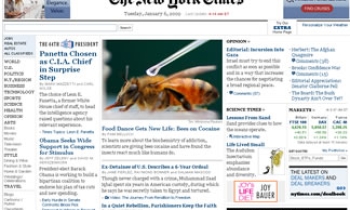As the sun scorched the Wyndham El Conquistador resort in Puerto Rico, publishing and advertising executives issued a heated call to action at the American Magazine Conference for magazines to expand their brands beyond a simple page and seek opportunities to engage readers and advertisers in the digital and wireless realm.
Such deployment of content to online and other digital mediums will not only cut distribution costs relating to printing and postage but allow less dependency on circulation guarantees to advertisers.
"Too many of our resources are focused on efficiently achieving an average paid circulation rate base guarantee, rather than focusing on distribution profitability and readership opportunities," said Jack Kilger, CEO of Hachette Filipacchi Media U.S. in a speech to attendees upon accepting his new role as president of the Magazine Publishers of America. "This focus has led to inefficient practices and missed opportunities."
Publishers agreed that the old advertising model of magazines, where the main revenue stream came from selling an ad page based on an often inflated rate base, will not be sustainable long term. Ad dollars are increasingly scarce since marketers have more print, televisions and online outlets to choose from. Instead, moving towards a system that integrates, for example,
a print component and an online or digital component, will encourage publishers to put less weight on one overall circulation number. This in turn will result in publishers cutting rate bases in the future as magazine’s readership and advertising revenue streams begins to diversify.
From the advertisers perspective, managing content across multiple channels will ignite creativity in print to develop integrated programs that will better harness a magazine’s brand power.
Marketers such as GM and Volkswagon are launching creative campaigns without analyzing how much money is dedicated to each medium; instead they are examining which medium best showcases creative ads to capture the most relevant audience.
What magazines need to do is apply their brand to more than just a page to stay compelling. "If I can take [a campaign] off of a printed page to merge two consumer bases, that’s really important," said Kerri Martin, director brand innovation, for
Volkswagon of America.
But despite the need to be creative, the debate over branded entertainment in magazines continued unabated. While, for example, Volkswagon’s Martin applauded a recent issue of The New Yorker that featured logos from Target within cartoons, many traditional print advocates were quick to slam the Condé Nast title for crossing the holy divide between edit and advertising.
Even Mark Whitaker, editor of Newsweek and president of American Society of Magazine Editors, recognized that The New Yorker should have included an editor’s note explaining the single advertiser sponsorship, but said the degree of the infraction warranted merely a "slap on the wrist" from the governing organization.
Nevertheless, Whitaker outlined changes to the ASME guidelines today that provided editors and publishers "the Ten Commandments" of product placement in magazines. The new guidelines, said Whitaker, "highlight the core principles that the difference between advertising and editorial content should be transparent to readers, and that editors should have final say over what’s appropriate for their readers and their brands."
The new guidelines specified, among other things, that sponsorship of non-recurring editorial features such as special issues, and inserts were allowed as long as the sponsorships are clearly labeled as advertising. The guidelines do not allow advertisers to placing products in stories in exchange for payment, but do permit editors to credit advertisers for product so long as those pages remain under editorial control.









